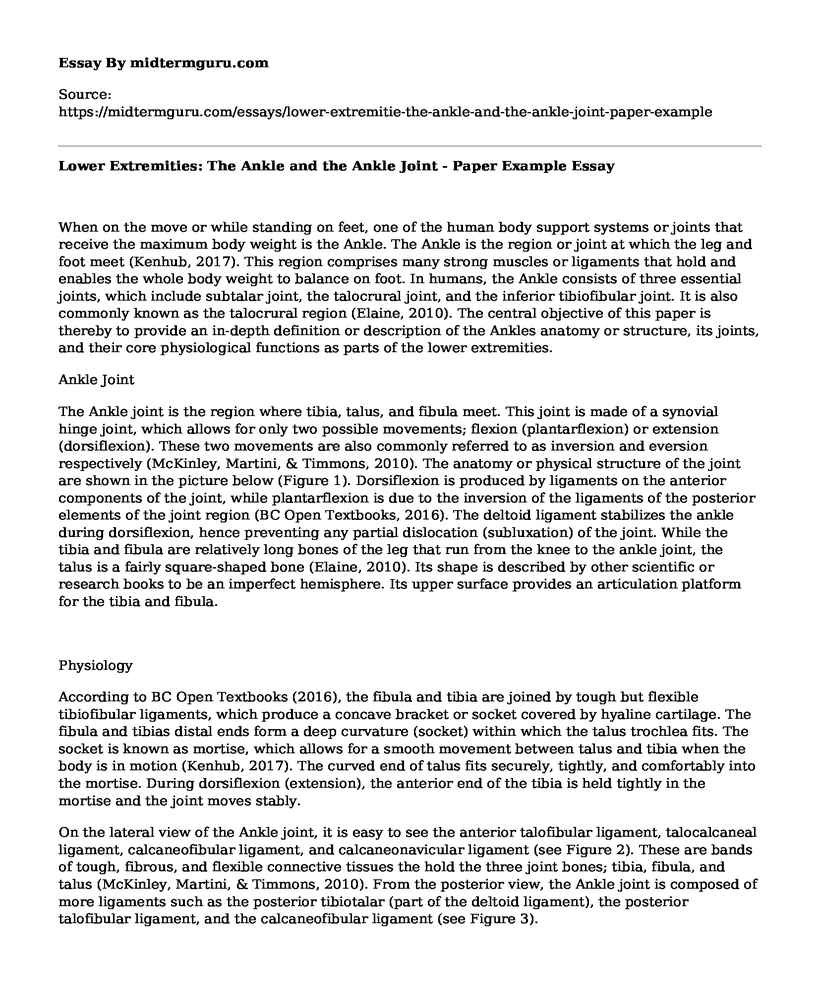When on the move or while standing on feet, one of the human body support systems or joints that receive the maximum body weight is the Ankle. The Ankle is the region or joint at which the leg and foot meet (Kenhub, 2017). This region comprises many strong muscles or ligaments that hold and enables the whole body weight to balance on foot. In humans, the Ankle consists of three essential joints, which include subtalar joint, the talocrural joint, and the inferior tibiofibular joint. It is also commonly known as the talocrural region (Elaine, 2010). The central objective of this paper is thereby to provide an in-depth definition or description of the Ankles anatomy or structure, its joints, and their core physiological functions as parts of the lower extremities.
Ankle Joint
The Ankle joint is the region where tibia, talus, and fibula meet. This joint is made of a synovial hinge joint, which allows for only two possible movements; flexion (plantarflexion) or extension (dorsiflexion). These two movements are also commonly referred to as inversion and eversion respectively (McKinley, Martini, & Timmons, 2010). The anatomy or physical structure of the joint are shown in the picture below (Figure 1). Dorsiflexion is produced by ligaments on the anterior components of the joint, while plantarflexion is due to the inversion of the ligaments of the posterior elements of the joint region (BC Open Textbooks, 2016). The deltoid ligament stabilizes the ankle during dorsiflexion, hence preventing any partial dislocation (subluxation) of the joint. While the tibia and fibula are relatively long bones of the leg that run from the knee to the ankle joint, the talus is a fairly square-shaped bone (Elaine, 2010). Its shape is described by other scientific or research books to be an imperfect hemisphere. Its upper surface provides an articulation platform for the tibia and fibula.
Physiology
According to BC Open Textbooks (2016), the fibula and tibia are joined by tough but flexible tibiofibular ligaments, which produce a concave bracket or socket covered by hyaline cartilage. The fibula and tibias distal ends form a deep curvature (socket) within which the talus trochlea fits. The socket is known as mortise, which allows for a smooth movement between talus and tibia when the body is in motion (Kenhub, 2017). The curved end of talus fits securely, tightly, and comfortably into the mortise. During dorsiflexion (extension), the anterior end of the tibia is held tightly in the mortise and the joint moves stably.
On the lateral view of the Ankle joint, it is easy to see the anterior talofibular ligament, talocalcaneal ligament, calcaneofibular ligament, and calcaneonavicular ligament (see Figure 2). These are bands of tough, fibrous, and flexible connective tissues the hold the three joint bones; tibia, fibula, and talus (McKinley, Martini, & Timmons, 2010). From the posterior view, the Ankle joint is composed of more ligaments such as the posterior tibiotalar (part of the deltoid ligament), the posterior talofibular ligament, and the calcaneofibular ligament (see Figure 3).
The two sets of ligaments that originate from the malleolus; the medial (deltoid) and lateral ligaments. The medial ligament connects to the malleolus, and it consists of 4 distinct ligaments which fan out from the malleolus, joining the talus, navicular, and calcaneus bones (Moore, Arthur, & Agur, 2013). The primary function of the medial ligaments is to resist extra-eversion of the foot. On the other hand, the lateral ligaments emanate from the lateral malleolus, and their core purpose is to resist extra-inversion of the foot (Kenhub, 2017). Its principal components are the calcaneofibular, posterior talofibular and anterior talofibular. In conclusion, the ankle and ankle joint thereby forms a superior joint region where tough but flexible ligaments join three major bones. The joint serves a unique purpose of aiding the leg movements only in two directions; the extension and flexion.
References
BC Open Textbooks (2016). Anatomy and Physiology: Chapter 8: The Appendicular Skeleton: 8.4 Bones of the Lower Limb. Retrieved on 9th March 2017 from https://opentextbc.ca/anatomyandphysiology/chapter/8-4-bones-of-the-lower-limb/
Elaine, M. N. (2010). Essentials of Human Anatomy and Physiology. San Francisco: Benjamin Cummings.
Kenhub (2017). Anatomy and Histology: Lower Extremity - The Ankle Joint. Retrieved on 9th March 2017 from https://www.kenhub.com/en/library/anatomy/the-ankle-joint
McKinley, M. P., Martini, F., & Timmons, M. J. (2010). Human Anatomy. Englewood Cliffs; N.J: Prentice Hall.
Moore, K. L., Arthur, F., & Agur, A. R. (2013). Lower Limb: The Ankle. Clinically Oriented Anatomy (7th Ed.). Lippincott: Williams & Wilkins. pp. 508669.
Cite this page
Lower Extremities: The Ankle and the Ankle Joint - Paper Example. (2021, Jun 09). Retrieved from https://midtermguru.com/essays/lower-extremitie-the-ankle-and-the-ankle-joint-paper-example
If you are the original author of this essay and no longer wish to have it published on the midtermguru.com website, please click below to request its removal:
- People Who Know They Have a Terminal Illness Should/Should Not Have Children
- The Impact of Working Parents - Essay Sample
- Paper Example on Plant-Based Diet to Reverse/Prevent Cardiovascular Disease
- Case Study: Language Barrier
- A Healthy Pregnancy - Essay Sample
- Paper Example on Immunization
- Smile Matters: Dental Appearance and Physical Perception - Essay Sample







